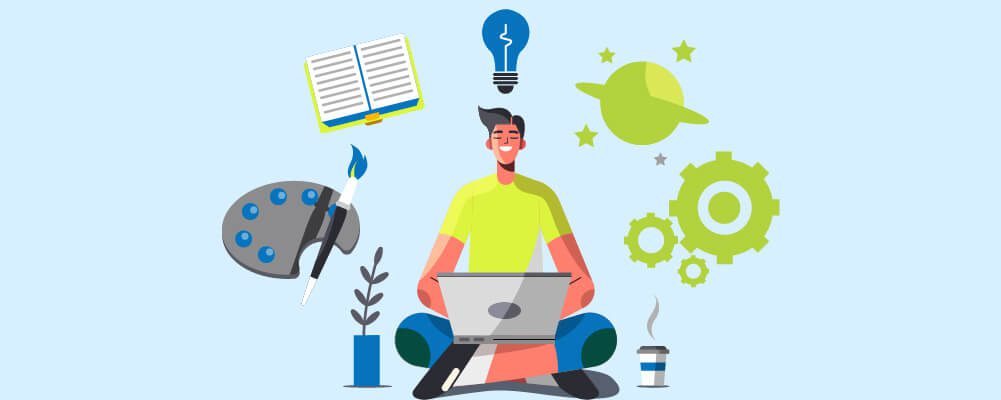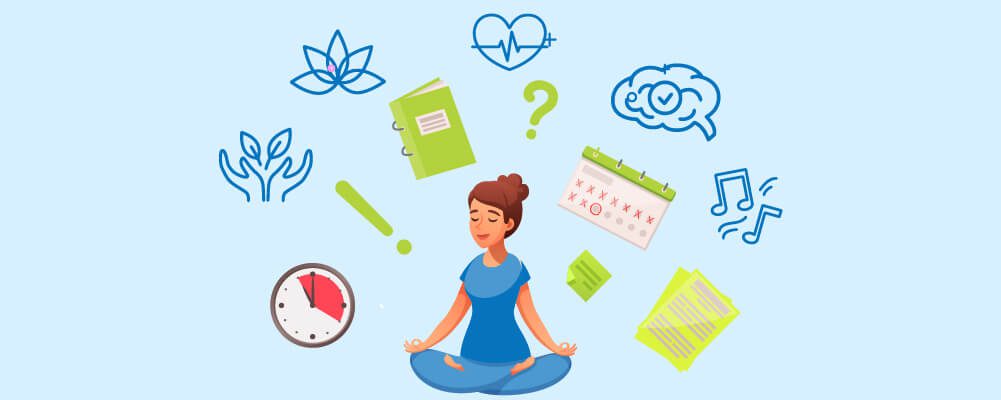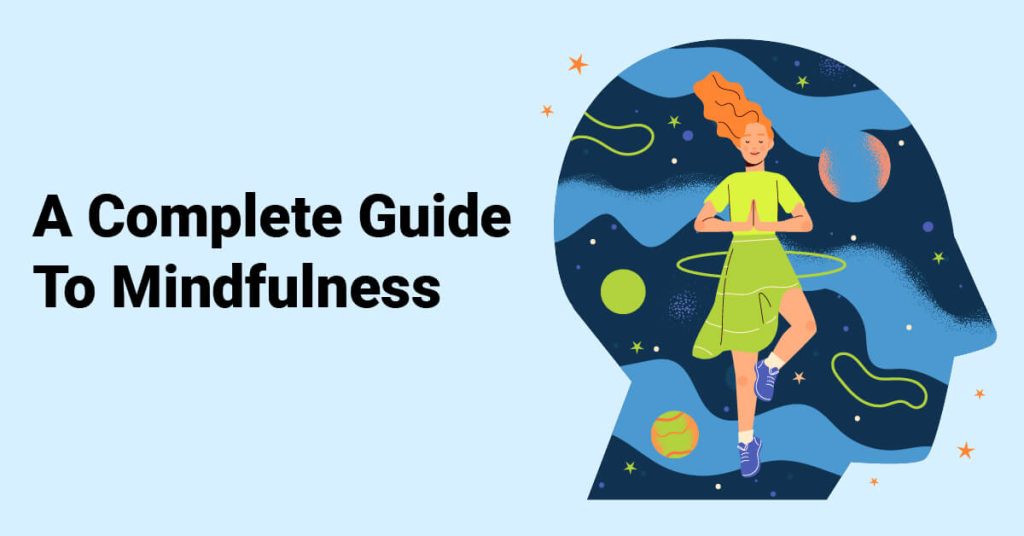Although most of us have realized the importance of mindfulness over the last decade, the practice isn’t new. Mindfulness has been around for centuries.
Regularly practicing mindfulness is the perfect way to calm your mind, recenter your emotions and keep yourself stable. If you keep up your meditations even when life is going well, you will be able to access that inner peace while the pendulum falls.
Today we want to guide you through this ancient process, to help you reach a level of tranquility.
[toc]
What is Mindfulness?

Most people practice mindfulness without really noticing. It’s a natural ability we all have to be fully aware of who we are, what we are doing, and what’s going on around us.
Because this is a natural ability we can do, it doesn’t take long to hone in on this self-awareness and actively participate in the moment.
In simple terms, mindfulness is when you become aware of your experiences either through your senses physically or through your thoughts and emotions.
When this happens, you can see yourself and your situation for what it is. The process re-centers your perspective and can help you understand the world around you.
The overall goal of mindfulness is to unlock your physical awareness, your emotional awareness, and your mental state of being. Opening up these pathways will help you understand and process your life in that moment.
Why Practice Mindfulness?

Although mindfulness is something we all have the capacity to achieve, like anything, actively participating in the activity will make it easier to accomplish.
It Trains Your Body To Thrive
Just as sleeping helps reset your muscles, repairing from the damage of the day, and allows them to rest, mindfulness can also reset your body.
Mindfulness allows you to step away from the logic of your life and helps you return to a more instinctual understanding of yourself.
You will feel your body, not as a meat sack that holds your brain together, but as the powerful force it is. While practicing mindfulness, you can feel each muscle in your body, understand where your aches and pains are, and even notice elements of your physical self that you were unaware of before.
It Boosts Creativity
With the ties of the world disconnected from you, your mind will be free to take in the raw elements of the world without distraction. It’s moments like these that clear your mind, almost like erasing a notebook ready for a clear day of thought.
With the worries and niggles of the day behind you, your mind can pick up on new ideas and see the world through a perspective previously blocked off.
Unlocking your mind like this is the perfect way to get past any writer’s block, or creative dry spells, as your mind can reset, just as your body does.
It Can Strengthen Neural Connections
Research has shown that practicing mindfulness allows us to mentally overcome stressful events. This is because, while we try and be mindful, we create new neural pathways and strengthen our ability to observe the world around us. This, in turn, allows us to “witness ourselves” from an outside perspective as our neural connections make more links.
This means we can see ourselves as others see us, and we can see the world around us without our own mind tainting the experience. This allows us to digest the information of the stressful event and emotionally overcome the problem at hand.
When we have more of these neural connections in our brain, we are able to understand problems from multiple perspectives, give us more ways to tackle a problem, and become flexible in our lives.
The flexibility comes from our ability to understand different methods and pathways in front of us.
What Is Meditation?

Meditation is a type of mindful practice, but instead of allowing yourself to feel the world in the moment, it instead encourages you to explore.
There is no fixed destination when you start to meditate; instead, you let your mind wander as it follows random thought after random thought.
There is a misconception that meditation requires the meditator to empty their mind of everything, but realistically that idea is impossible. Instead, we watch our minds work as a method to reach mindfulness.
For example, as you sit and focus on your breathing, you might notice the sensation of air blowing against your skin, or you might feel the emotions of your day start to creep into your mind.
While you meditate, your aim is to follow this train of thought without judging it. Let it come to a natural conclusion to help you release any negative energy and work through any emotional struggle.
Listening to your mind without judgment can help you understand why you feel a certain way. It can help you understand the situation ahead of you and settle in a place of kindness.
Benefits Of Meditation

When we meditate, we aren’t aiming to complete a goal but simply allow ourselves to complete the thought without judgment. Still, when you are just starting out or wondering what all of this is about, it can be helpful to understand how this practice can benefit you.
Below is a small list of ways in which meditation can help you throughout your life. This isn’t an exhaustive list, as you will find out for yourself just how impactful it can be for your mental and physical health.
Understanding Your Pain
Painful moments, both physical and mental, will happen in your life. You cannot stop it. It is a natural occurrence that happens to us all. However, this pain doesn’t have to rule over you. You can use meditation to unpack the struggles in your life and find a balance between hurt and acceptance.
When it comes to physical pain (like chronic pain syndrome,) there has been research which shows that mindful meditation can reduce pain and symptoms. Mediation allows you to compartmentalize your physical distress and gets you to disconnect from this physical element of your life.
Better Connection
After meditating and understanding yourself with more clarity, you will realize that you begin to understand your friends and family better too. Your connections to their conversations, thought patterns, and desires will become clearer as you are able to make judgment-free observations.
As you have allowed your mind to wander through your thoughts without judgment and without a timeframe, you’ll notice that your mind doesn’t wander when you are talking with friends. This means your attention span will have grown, and your emotional intelligence will have enhanced too.
For most of us, connecting better to our friends and family is all we really need. If we can gift them our attention and understanding, then our worlds will be that much nicer.
Less Stress
Most research around mindfulness and meditation is about how it can reduce our stress levels. Studies show that being able to detach yourself from the situation and become an observer can give you a sense of awareness. This awareness without attachment allows you to unpick your problems without adding to the stress of the situation.
Many researchers have agreed that this method is a powerful tool for cognitive behavioral therapy. Specifically, as a coping strategy when major life events transform our lives in stressful ways.
Reducing Brain Chatter
If you’re the type of person that cannot get your brain to shut off, practicing meditation and mindfulness can teach you how to slow down and take a break.
Brain chatter is often connected to stress, although some people cannot distinguish between the two. Giving yourself some time to relax and step away from the stresses of your life can help you quiet the voices in your head.
A study has shown that meditating between stressful points in your life, like exams, important meetings, or seeing people you’d rather avoid, can help you quiet the negative thoughts in your head and become a calmer version of yourself.
Focus Your Mind
With your stress reduced, the chatter quietened, and the pain lower than before, you will be able to focus on your mind much more effectively.
Your ability to actively focus will massively improve once you start meditating, as you will have tackled and understood your problems during the session. Having put in the hard work through meditation, your brain will not begin to wander off the moment you try to focus.
Clarity comes when you are able to organize your thoughts, and with a mental workout completed, you will have paved the way for concentration.
To keep all of these benefits going, you will need to practice meditation at least once a week. That way, you will be constantly on top of your emotional struggles and continue finding clarity.
Basics Of Mindfulness Practice

If you’re just getting into mindfulness, the process of letting go can feel strange or even embarrassing. We are going to guide you through this new ideal and help you create a space of calm.
Remember that although this process is almost instinctive, it can take a while to truly step into this mindscape. Take your time, don’t put pressure on yourself, and try to relax.
1. Set Aside Some Time
You don’t need to be out in the open air, nor do you need a special cushion or chair. All you need is a private space and time.
Ideally, you should practice mindfulness and meditation when you are free from outside obligations. If you’ve just taken the kids to school, and have a couple of hours to yourself before other tasks need to be done, then this could be the perfect time to practice.
Or if you know you have a 30-minute break at work, and you can find a quiet room, this could be the time you need.
Whatever your daily life looks like, try to find a moment in time that you can dedicate to mindfulness. Then, look for a quiet and private space that will not distract you from your aims.
2. Observe The Present Moment
Now it’s time to be aware of the present moment. You don’t need to clear your mind, nor do you have to aim for complete calm. Instead, you should pay attention to how you feel and what you sense in this moment. Do so without judgment.
It can be helpful to say these feelings out loud or in your head to help you stay on track.
Notice the breeze on your skin, the heaviness of your legs, the anxiety of someone opening your door, the realization that you are safe.
Note the feelings as they come, and then let them float away again.
3. Let Judgments Roll By
In this moment, you will notice judgments spring into your mind. This is not the time to correct them or be embarrassed about them. Remember that as humans, it is natural for us to make quick conclusions that we can later analyze. Instead of analyzing the judgment now, simply make a note of it and let your mind continue to wander.
As you continue to practice this method of releasing any judgments, it will become easier and easier to achieve. You cannot expect yourself to be an expert in this straight away; all you can do is try again.
If you find yourself getting wrapped up in a judgment, take a breath and let your mind go again.
4. Return To Observing The Present Moment As It Is
Even the best meditators need to remember this step. It’s normal for your mind to wander into the past or into the future, and sometimes it can take a while for us to notice that it’s even happened.
If you realize you haven’t been thinking about the “now,” then you need to refocus your mind. You might need to practice returning every couple of minutes, but eventually, you will be able to stay longer and longer in the present.
Having to return doesn’t mean that you’re failing at mindfulness either. Just like anything else, it takes practice to get it right. Let any judgments on yourself float away and turn to the present.
5. Be Kind To Your Wandering Mind
As your mind wanders, you may find it going down a darker path than you expected, or it could be completely blank as you look around the area. Wherever your mind goes, don’t judge it.
Be kind, and allow yourself to have this moment of pure mental freedom. Only you are seeing this traveling progression, so you don’t need to be embarrassed or concerned.
It is normal for your mind to think up weird or dangerous thoughts, especially if they don’t linger. When something unusual happens, simply acknowledge it and be thankful that you have given yourself this safe space.
How To Meditate

Mediation is very similar to general mindfulness, but we often focus on our breathing. This is so we can concentrate on the physical sensations inside our bodies, through our lungs, and outside our bodies as the air leaves us.
These physical movements and gentle sensations can help you stay in the moment and anchor yourself to the present.
If you find yourself drifting off, go back to your breathing.
1. Sit Comfortably
Ideally, your meditation should last between 40 and 45 minutes, so you need to make sure you are comfortable. If you start off in an uncomfortable position, it will be more likely that you’ll be pulled out of your calming sensations.
Find a location that is quiet, stable, and comfortable. Take a seat, and prepare yourself for a long time of not moving.
You may find that sitting on the floor is comfortable, or sitting crossed-legged on some cushions might also be preferable. But you can also sit on your couch or lie on the floor.
As long as you are safe to switch off mentally in the area you have chosen, and you are comfortable, then you can sit however you please.
2. Pay Attention To Your Legs
However you have decided to sit, be aware of your legs. If you are sitting on a chair, rest both of your feet on the floor. If you are sitting cross-legged, be sure to have a cushion protecting your ankles.
If your legs are strained, or your body is holding you inappropriately, then you will start to feel pain after a couple of minutes. This will take you out of the moment you are creating, stopping your meditation early.
To ensure that you will not be interrupted, you should concentrate on your legs or any part of your body that could upset you in a couple of minutes. If you feel comfortable, you can begin.
3. Straighten Upper Body
You don’t need to be as straight as a lamppost, but we don’t want you to ruin your posture. Sitting up straight will stop you from getting an achy back during this process.
Posture is also important in keeping you balanced, which is the whole reason for this exercise. Finding a balance in your body will help you find a balance in your mind too.
Lastly, sitting up straight will allow you to open your lungs more. As we are concentrating on breathing to keep you grounded in the present moment, you need your lungs to be unobscured, so you can breathe with ease.
4. Notice What The Arms Are Doing
Your arms should be parallel to your upper body, not curling over or holding onto anything. Basically, you can let them fall naturally against your sides. Next, you want your palms to rest either in your lap or by your side, whichever feels the most natural.
Settle yourself into this position, and allow your arms to relax and loosen from your day.
5. Soften Your Graze
As you settle into your sitting position, you should gently drop your chin just a little and let your gaze fall downwards. At this point, you can close your eyes, or you can keep them open.
In this position, you should feel slightly disconnected from the distractions ahead of you, and instead, your mind will start to focus inwards.
Try not to focus on anything around you. Let your gaze soften and cloud over. Now you should be entering your mindscape and allowing the world around you to fall into a blur.
6. Feel Your Breath
As your mind turns inward, it may need something to stop it from wandering too far. For now, you should concentrate on your breathing. The physical sensation moving from your nose into your lungs and back through your mouth is a circular rhythm to keep you centered. It might help to keep your hands over your stomach, so you can feel your chest rising and falling.
If you need more of a physical sensation, you may notice the air around your mouth and nose moving in the same rhythm as your body. Notice how you and the elements are one in this moment.
This is what you should be focusing on. This moment, this earthly connection. Now, try and stay there.
7. Notice When Your Mind Wanders Away From Your Breath
No matter how long you have practiced meditation, every now and then, your mind will start to wander away from your breathing. Although there is nothing wrong with letting your mind wander every now and then, this exercise is about connecting to your body and living in the moment.
When your mind goes off, try to reign it in and concentrate on your breathing again.
If it keeps wandering, you might find another technique helpful. Some say a word on repeat, others trace a pattern on repeat. The idea is the same, as you are centered in this physical moment with a clear mind.
8. Be Kind About Your Wandering Mind
When your mind does start to wander, don’t get upset with yourself. It could be that these moments of silence have produced something important. To help yourself get back on track, listen to your thoughts and observe them without reacting. This balance can be hard, but once the thought has been completed, you can go back to breathing again.
Do not judge yourself or your thoughts in this moment; just let them pass without expectation.
Always be kind to yourself, as these momentary feelings do not necessarily reflect upon you.
9. When You’re Ready, Gently Lift Your Gaze
Although we said that meditation should last for around 40 to 45 minutes, you hold the real time frame is how long you need it for. After 30 minutes, you could feel your body relaxing, your thoughts clearing, and your emotions regulating.
Whenever you feel that you have completed this moment of clarity, you can slowly open your eyes. Right now, you will be feeling drowsy, spiritual and might feel a little clumsy in your body. This is normal as you reconnect to the world around you.
Before you try to move, take in the world slowly. Listen for the sounds that surround you to bring you back into your space and slowly move your arms to reconnect to your physical body.
Take in your body and mind, and notice which thoughts or emotions are coming back to you. You should be feeling calm, relaxed, and confident.
Very slowly begin to stand. You might feel dizzy, so take the next hour or so with care, and be sure to drink plenty of water.
Mindful Practices for Every Day

If you practice mindfulness every day, you will feel yourself changing. You’ll notice a calmer and patient side of you as you interact with your daily life.
You’ll notice how kind you are both to yourself and to others as you develop a new level of understanding and outsider perspective. You’ll also notice how much happier you are as you manage to digest your emotions and thoughts throughout the day.
To help you practice mindfulness, here are a couple of easy methods for you to follow.
Walking Meditation
Walking meditation starts the same way as our sitting meditation method before. You keep your back straight but not stiff, and this time, you concentrate on your feet.
With one hand, curl your fingers around the thumb of another. This keeps you connected to your body and stops you from getting distracted with swinging arms.
Next, drop your gaze only slightly. As you are walking, you still need to be aware of where you are stepping.
Then either follow the rhythm of your breathing or your feet. You can use the technique above if you are following breathing.
If you follow your feet, you should concentrate on the natural swing in your movement, the feeling of your heel touching the ground and the curve in pressure as you stand on the ball of your foot, and then the toes.
Concentrate on these physical rhythms and keep a slow but steady pace.
Mindful Listening
Mindful listening combines attention to the words and the speaker’s intention with your genuine response.
Ironically mindful listening is often about how you feel and how you react, more than what the person is saying. Although this might seem self-centered, it allows you to create a genuine response without butting into the conversation.
When someone is speaking, ask yourself how you are feeling and if something will stop this conversion. For example, if you cannot concentrate because you need to finish a task, then tell the speaker this.
Once the task has been completed, you can go back to the speaker with your full attention.
Next, you need to be present in the conversion. Listen fully, connect empathetically and find an interest.
If you have a reaction, make a silent note about it. When it’s your turn to speak, you can bring it up then.
When you respond to the speaker, repeat back what you have heard by using your own words. This shows the speaker that you are genuinely listening and allows you to digest the information for a second time.
Lastly, use open-ended questions to give the speaker room for more information and ask for the speaker’s point of view before adding our own ideas.
Loving And Kindness Practice
Comparing yourself to others, telling yourself negative things, or going over past events can not only be harmful to your self-esteem and positivity, but it can also take up a huge amount of energy.
Instead, you should try actively being kind and loving yourself. At first, you might feel silly, but you will end up being much happier by taking up this practice.
First, you should take a moment every day to appreciate all the good things that you do. Maybe you help your neighbor with their mail, or you clean the house, or perhaps you make people laugh. Rejoice in this amazing thing that you do.
Next, tell yourself something that you sincerely wish for. Recite it two or three times. Common phrases are “May I have mental happiness,” “May I live in safety,” and “May I achieve clarity.”
Each time you notice your mind drifting to negative thoughts, recite these phrases again, and block them from judging you.
When you can, imagine yourself surrounded by the physical representations of the kindness in you. The good moments in your life, the times when you were proud.
Allow them to hug you and protect you. Recite your positive thoughts until you feel the love you deserve.
Wind Down And Fall Asleep
In a world filled with technology, allow yourself to escape these lights and constant stimulation around 1 hour before you go to bed.
In this moment, you can start your meditation or simply talk to your loved ones.
About 10 minutes before you go to bed, sit in a dimly lit room and imagine the outline of your body. In your mind, trace the outline of your shape starting from your head.
With each line, release the pressure being held on that part of your body. Notice how your head is lying against your chair; feel your back resting in comfort. Take in this physical connection.
If your mind wanders, bring it back to your body.
As your mind starts to rest, take yourself to bed.
Summary

Using our guide and giving yourself time, you will be able to reach a new state of mindfulness. Once you start practicing these techniques, you will feel calm, kinder and will understand the people around you more. Mindfulness can help you reach a state of tranquility and clarity that might otherwise be lost in a scattered brain.

